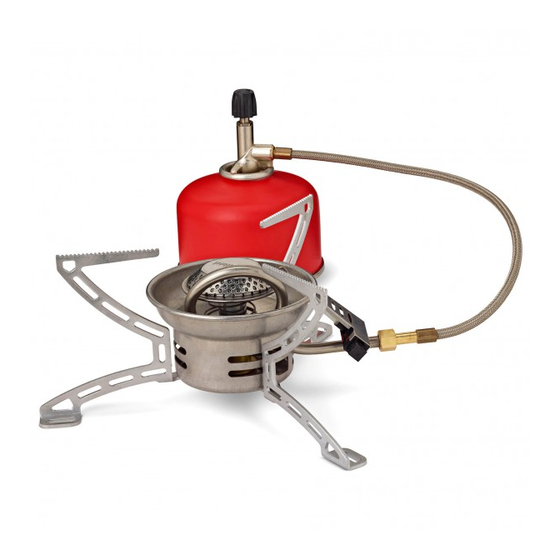
Table of Contents
Advertisement
Advertisement
Table of Contents

Summarization of Contents
SAFETY
Safety First
Essential safety precautions and warnings for stove operation.
FUEL
Fuel Selection Guide
Comparison and suitability of different fuel types for the stove.
FUEL TYPES
Kerosene and Paraffin
Details on using kerosene/paraffin as fuel, including pros and cons.
Jet Fuel Considerations
Information on using jet fuel, its relation to paraffin.
Diesel Fuel Use
Considerations for using diesel fuel, especially with LFS models.
Avoid Alcohol and Spirits
Recommendation against using alcohol or spirits as stove fuel.
COOKING LOCATIONS
Outdoor and Indoor Cooking Advice
Guidance on suitable and prohibited cooking locations for the stove.
STOVE ASSEMBLY
Attach Pump to Fuel Bottle
Instructions for attaching the pump to the fuel bottle correctly.
Connect Stove to Pump/Cartridge
Procedure for connecting the stove unit to the pump or gas cartridge.
Deploy Stove Legs
How to extend and secure the stove's legs for stability.
OPERATING THE STOVE
Lighting with Gas (MFS)
Steps for igniting and operating the stove using gas cartridges.
Liquid Fuel Startup and Priming
Guide to starting and priming the stove with liquid fuel.
FLAME CONTROL
Adjusting Flame Size
How to regulate the flame size for maximum heating and efficiency.
Simmering with Liquid Fuel
Techniques for achieving a low flame for simmering with liquid fuel.
TURNING OFF THE STOVE
Shutting Down Gas Operation
Procedure for safely turning off the stove when using gas cartridges.
Shutting Down Liquid Fuel
Steps to shut down the stove and bleed the fuel line for liquid fuel.
Changing Fuel Containers
Instructions for safely changing empty fuel bottles or cartridges.
OPERATIONAL HINTS
Stove Handling and Storage
Guidelines for safely handling, packing, and storing the stove.
Additional Safety Tips
Additional practical tips and crucial safety reminders for stove use.
FUEL SAVING
Fuel Conservation Methods
Practical methods to conserve fuel during cooking operations.
COLD WEATHER OPERATION
Gas Use in Cold Climates
Advice on using gas cartridges effectively in cold temperatures.
Enhancing Gas Evaporation
Methods to ensure gas vaporization for optimal performance in cold.
COLD WEATHER OPERATION
Liquid Fuel in Cold Weather
Precautions and tips for operating with liquid fuel in cold conditions.
HIGH ALTITUDE PERFORMANCE
Gas for High Altitudes
Reasons why gas is preferred for cooking at very high altitudes.
Liquid Fuel at High Altitudes
Performance of liquid fuels like kerosene/paraffin at high altitudes.
MAINTENANCE AND CLEANING
Lubricating Pump Leather Seal
Procedure for lubricating the pump's leather seal for optimal function.
MAINTENANCE AND CLEANING
Cleaning the Jet Nipple
Steps to disassemble and clean the stove's jet nipple.
Cleaning Generator and Fuel Line
Instructions for cleaning the generator and flushing the fuel line.
MAINTENANCE AND CLEANING
Safety Checks and Leak Detection
Important safety guidelines and how to check for leaks using soapy water.
TROUBLESHOOTING
Insufficient Heating
Diagnosing and resolving issues with the stove not heating adequately.
Resolving Fuel Leaks
Identifying and fixing leaks in the stove system, with safety warnings.
Fuel Bottle Pressure Issues
Addressing problems with the fuel bottle not holding pressure or leaking.
TROUBLESHOOTING
Flame and Hissing Problems
Troubleshooting irregular flames, hissing, and spitting issues.
COMPATIBILITY
Fuel Bottles and Cartridges
Information on compatible fuel bottles and gas cartridges for the stove.
Critical Compatibility Warnings
Key points regarding plastic bottles and fill lines for fuel bottles.
FUEL ACQUISITION
Gas Cartridge Systems
Overview of common gas cartridge connection systems.
Purchasing Stove Fuel
Where to buy fuel and advice for obtaining it in remote locations.
FUEL COMPARISON
Energy and Priming Data
Table comparing energy content, performance index, and priming time of various fuels.














Need help?
Do you have a question about the Himalaya VariFuel and is the answer not in the manual?
Questions and answers